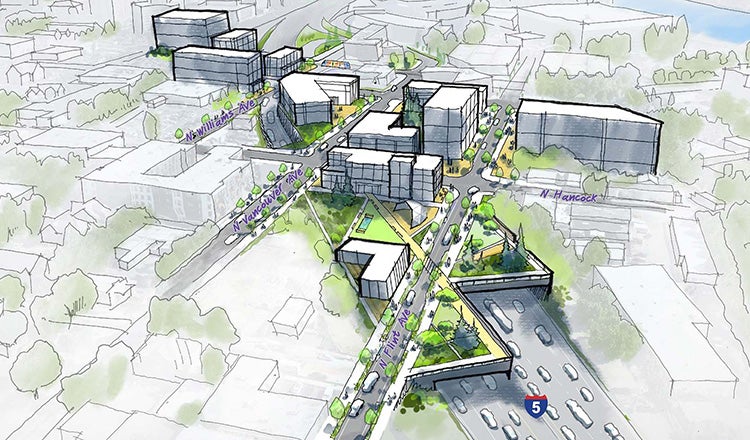I-5 Rose Quarter Improvements

I-5 Rose Quarter Improvements
A Community-Transforming Highway Cover and Corridor Upgrades
When Interstate 5 was constructed through Portland, Oregon, in the 1950s, it cut through the heart of the city’s historic Albina district. Generations of Black families still live with the repercussions of the project that destroyed homes, businesses and social institutions in Northeast Portland and displaced its established residents.
Today, the Oregon Department of Transportation is working to mend some of that harm and reconnect the community after decades of division. The Rose Quarter Improvement Project will improve safety and congestion on what is now the state’s top traffic bottleneck. In addition, it will reconnect the Albina neighborhood through a new highway cover that will create additional space for community development.
HDR has provided a wide variety of services as ODOT moves the project forward, including but not limited to NEPA and environmental permitting, concept development, complete streets implementation, interchange design, complex traffic modeling, coordination with event operations, transit design, right of way services, preliminary engineering, fire life safety, building engineering services, and highway cover structure design and capacity evaluation of buildings on bridges.
Complex Traffic Design Capped by a Highway Cover
The Rose Quarter project will add auxiliary lanes and shoulders to I-5, the main north-south freeway on the West Coast. It will also redesign the local street network to be more multimodal, with features specifically for pedestrians and cyclists. The addition of a pedestrian and bicycle bridge across I-5 will complement these accessibility improvements. But the most dramatic change will be the highway cover, which will replace five existing bridges with a continuous structure that will better reconnect the two sides of I-5. The added surface space will provide opportunities for various types of public spaces and create development opportunities. It will also create new options for bicycle facilities, making the area more walkable and bike friendly.
The 1,500-foot highway cover concept will reconnect local streets and create new community spaces for future development and economic opportunities. Depending on the final design, the cover will be able to support buildings from three to six stories tall. The HDR team is supporting early planning and outreach to help formalize the community vision for the cover. The highway cover development process will be led by the City of Portland, in partnership with ODOT, with strong community involvement.

This graphic is for illustrative purposes only and does not represent a final design.
Complicating project planning and design further, the area is in the middle of an event district. The nearby Moda Center and surrounding event district hosts more than 200 events per year and is the home of the Portland Trailblazers. Some of the events can draw up to 20,000 attendees. Designers needed to account for these event conditions as they plan the transportation system, ensuring that the improvements can efficiently manage these temporary surges in traffic.
Working Together to Advance Transportation Solutions
Such a complex project has required the expertise of many different disciplines. More than 200 HDR staff from more than a dozen states have contributed to the project working directly with ODOT and multiple city departments. Highway covers are still an emerging practice, and our team includes not just bridge engineers but also fire and life safety experts, traffic and roadway engineers, and building engineering professionals.
The collaboration will continue as the design progresses toward construction. The cover is being delivered through a construction manager/general contractor, or CM/GC, delivery method, which brings the contractor into the process during design to provide efficiency and to help identify areas of opportunity on the project.
The transformative project will reshape eastern Portland in the coming years. A Revised Supplemental Environmental Assessment for the main construction package — including the highway cover — won federal approval in spring 2024. The same month, the project was awarded a $450 million Reconnecting Neighborhoods and Communities Grant grant that will go toward detailed design and construction of the core part of the highway cover.







